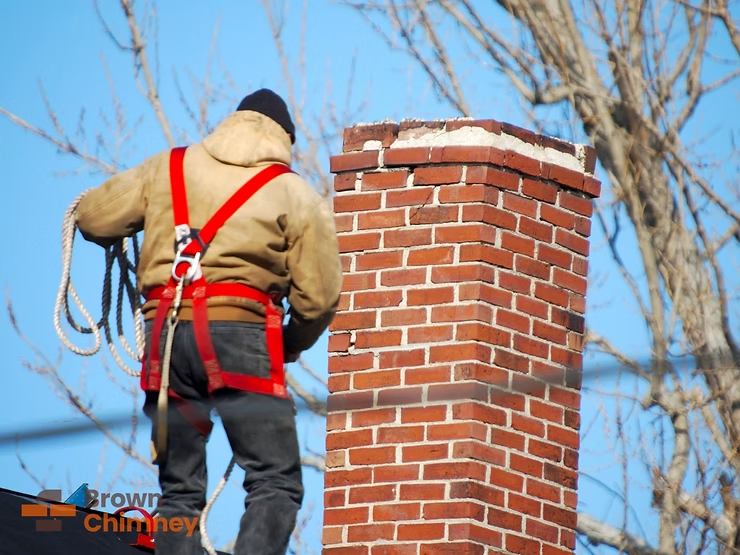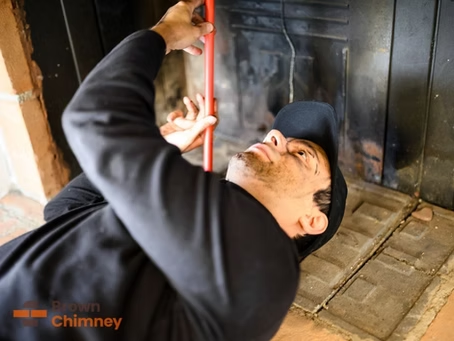Do Modern Chimneys Still Need a Sweep? What Homeowners Get Wrong
informed decisions, maintain your property, and ensure long-lasting protection.

Homeowners often think modern chimneys, especially gas or prefab systems, don’t need upkeep—but they’re wrong. Just because a chimney looks clean doesn’t mean it’s working safely. These systems can still hide creosote, corrosion, or blockages.
What causes problems in newer chimney systems?
Even without a wood-burning fireplace, your chimney can still fail in ways you won’t catch until there’s damage. Here’s where the trouble really starts:
- “It’s gas, so it’s clean."
Gas burns cleaner than wood, but it still produces moisture. Acidic condensation from gas appliances can also eat through aluminum liners or damage masonry flues lined with improper materials. If your system isn’t venting properly, gases like carbon monoxide can back up into your home without warning.
- Prefab and metal-lined systems aren’t hands-off.
Many modern chimneys use prefab units with metal flues. These are engineered to precise specs, which means even a small alignment issue or liner breach can create gaps that lead to heat damage or fire risk. Creosote can still build up in wood-burning prefab fireplaces. Because of how sensitive these systems are, tiny blockages or buildup can cause issues fast.
- Chimney caps and liners don’t prevent everything.
A blocked cap stops smoke and gases from escaping. That can send exhaust back inside, including CO. If water gets past a cracked liner, it can soak the masonry and freeze, breaking apart the flue from the inside.
- Home insurance and warranty claims may require proof of maintenance.
After a chimney fire or structural damage, insurance companies often ask for proof of maintenance. Missed inspections can lead to denied claims. Some appliance warranties also require proof of annual chimney servicing.
- DIY chimney kits aren’t a real substitute.
Homeowners sometimes try to do a light sweep with a brush kit. However, these tools can’t detect creosote glaze, spot hidden cracks, or identify barriers. They also can’t run a flue camera or diagnose structural risks. That false sense of “clean enough” can be risky. Glazed creosote can’t be removed without rotary tools or chemical treatments. Most DIY kits aren’t built for that.
What’s involved in a modern chimney inspection?
Sweeping soot is just the start. Here’s what a full chimney inspection now includes.
- Appliance expertise. Each fuel type burns differently, which affects what a sweep needs to find. Sweeps tailor their inspections based on where each system tends to break down. Gas inserts, for example, might corrode the liner without leaving soot. That corrosion often starts in hidden seams where acidic condensate pools completely out of sight. Pellet systems can also produce fine ash that clogs narrow flues.
- Full-structure inspections. Surface-level cleaning won’t catch flue cracks, moisture behind bricks, or signs of past chimney fires. For example, melted flue liners from a previous incident often go unnoticed without a camera scan. Because these failures happen inside, most homeowners don’t catch them until there’s visible damage or a draft problem.
- Safety steward. Burning wet wood or debris causes long-term damage to the flue, even if it doesn’t create much visible buildup. Sweeps can often spot signs of poor fuel use, like sticky residue or warped liner joints, long before it becomes a fire hazard. Some sweeps can even tell if treated lumber or trash was burned based on residue color or odor.
- Homeowner education. After the inspection, a good sweep doesn’t just hand over a checklist of what they did. They educate since most homeowners don’t know what a draft failure looks like on paper, so sweeps translate inspection results into clear, actionable decisions. Experts like Brown Chimney also suggest ways to properly maintain the chimney before and after a professional inspection.
- Emergency awareness. Sweeps are trained to act fast if they uncover signs of danger. They flag what’s urgent and help get repairs underway before the next use. That can include loose connectors, flue breaches, or signs of CO risk—things that need action before the next chimney use.
Why do modern chimneys need routine inspections?
Most homeowners don’t ignore chimney maintenance on purpose. A lot of prefab and gas units are sold as “low-maintenance” or even “maintenance-free,” so that’s how most people treat them. Local codes don’t support that assumption, though, and neither do safety records.
The 2024 International Fuel Gas Code requires all venting systems to be “installed, maintained, and inspected” according to manufacturer guidelines. That includes metal flues, prefab units, and gas-burning appliances, not just open fireplaces. These aren’t suggestions; they’re baked into national safety codes and enforced in many areas.
What makes this tricky is that chimneys don’t give reminders. There’s no warning light for a failing flue or draft issue. Problems like cracked liners or loose connectors can build slowly without showing any surface signs. Moisture can sneak in early, and even minor seepage breaks down masonry from the inside. A blocked cap restricts exhaust flow just enough to affect safety, without showing obvious signs like smoke in the room. Once damage becomes visible, it’s rarely cheap to fix. Sometimes, it’s also too late to prevent further failure.
That’s why both the Chimney Safety Institute of America (CSIA) and the National Fire Protection Association (NFPA) recommend annual chimney inspections, even for gas appliances. For wood-burning systems, sweeping is typically advised every year or after every full cord of wood burned.
Wrap-up: The smartest fix is early detection
Technology didn’t replace chimney sweeps—it raised the bar. Failures still happen, and they just show up in different ways: corrosion, hidden gaps, or draft issues. At Brown Chimney, we’ve seen it all: warped prefab fireboxes, cracked stainless steel liners, flue blockages hiding behind clean-looking vents. In every case, the owner assumed their system was fine, until it wasn’t.
Being proactive is the best defense against chimney-related hazards. Modern chimneys aren’t cheap, so a routine sweep can help you get your ROI efficiently. If you’re not sure when your last inspection was, don’t wait for a sign that something’s wrong. Schedule with Brown Chimney before a small issue becomes a full rebuild.
RELATED ARTICLS

.webp)
Schedule an Inspection Now
with expert chimney care.







